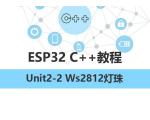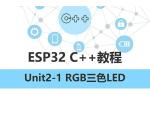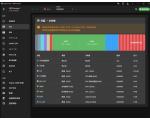25.SSD1306库驱动OLED

相对于U8G2库, 此库功能少了很多, 相对的RAM ROM占用也都少,那个绘制进度条是很有亮点的
依然接硬件IIC SCL: 22 SDA: 21
一. 如何使用库
引入库(我的是IIC接口)#include "SSD1306Wire.h"
实例化一个SSD1306Wire对象
SSD1306Wire display(0x3c, 21, 22);
初始化屏幕
display.init();
显示和清除
display.clear();
display.display();
二. 相关API
1. 清屏, 清除显示buf区, display.clearvoid OLEDDisplay::clear()
display.clear();
2. 清除某个点 display.clearPixel
void OLEDDisplay::clearPixel(int16_t x, int16_t y)display.clearPixel(0,0);
3. 显示, 显示buf区的内容 display.display
void SSD1306Wire::display()display.display();
4. 把显示屏关掉 display.displayOff();
5. 把显示屏打开 display.displayOn();
6. 深度睡眠后恢复 display.allocateBuffer();
//使用它可以在深度睡眠后恢复而不重置显示(init()会做什么)。//如果已建立与显示器的连接并分配了缓冲区,则返回true,否则返回false。
display.allocateBuffer();
7. 关闭OLED,清除对象和缓存 display.end();
void OLEDDisplay::end()
8. 屏幕垂直翻转 display.flipScreenVertically();
display.flipScreenVertically();
9. 屏幕镜像显示 display.mirrorScreen();
display.mirrorScreen();
10. 反色显示 display.invertDisplay();
display.invertDisplay();
11. 回归正常显示 display.normalDisplay();
display.normalDisplay();
12. 重新初始化 display.resetDisplay();
display.resetDisplay();
13. 重置显示方向 display.resetOrientation();
display.resetOrientation();
14. 设置显示亮度 display.setBrightness();
void OLEDDisplay::setBrightness(uint8_t)
15. 设置对比度 display.setContrast()
void OLEDDisplay::setContrast(uint8_t contrast, uint8_t precharge = (uint8_t)'�', uint8_t comdetect = (uint8_t)'@')设置显示对比度
例如: 极低的亮度和对比度:对比度= 10,预充电precharge= 5,comdetect = 0
正常亮度和对比度:对比度= 100
三. 绘制相关API
1. 设置一个点 display.setPixel这是一下所有绘制方法的基础
void OLEDDisplay::setPixel(int16_t x, int16_t y)
2. 画空心圆 display.drawCircle
void OLEDDisplay::drawCircle(int16_t x, int16_t y, int16_t radius)display.drawCircle(64,32,20);
3. 画实心圆 display.fillCircle
void OLEDDisplay::fillCircle(int16_t x, int16_t y, int16_t radius)
4. 画1/4圆弧 display.drawCircleQuads
void OLEDDisplay::drawCircleQuads(int16_t x0, int16_t y0, int16_t radius, uint8_t quads)display.drawCircleQuads(32,32,20,1);
其中: quads是角度

5. 画水平线 display.drawHorizontalLine
void OLEDDisplay::drawHorizontalLine(int16_t x, int16_t y, int16_t length)display.drawHorizontalLine(0,20,100);
6. 画垂直线 display.drawVerticalLine
void OLEDDisplay::drawVerticalLine(int16_t x, int16_t y, int16_t length)
7. 画线 display.drawLine
void OLEDDisplay::drawLine(int16_t x0, int16_t y0, int16_t x1, int16_t y1)
8. 画空心矩形 display.drawRect
void OLEDDisplay::drawRect(int16_t x, int16_t y, int16_t width, int16_t height)
9. 画实心矩形 display.fillRect
void OLEDDisplay::fillRect(int16_t x, int16_t y, int16_t width, int16_t height)
10. 画进度条 display.drawProgressBar
void OLEDDisplay::drawProgressBar(uint16_t x, uint16_t y, uint16_t width, uint16_t height, uint8_t progress)进度取值0~100
四. 文本相关API
1. 设置字体 display.setFontvoid OLEDDisplay::setFont(const uint8_t *fontData)
| 内建字体 | 字高 | 字宽 | 包含字符 |
| ArialMT_Plain_10 | 13 | 10 | 224个字符 |
| ArialMT_Plain_16 | 19 | 16 | 224个字符 |
| ArialMT_Plain_24 | 28 | 24 | 224个字符 |
2. 设置文本对齐方法 display.setTextAlignment()
void OLEDDisplay::setTextAlignment(OLEDDISPLAY_TEXT_ALIGNMENT textAlignment)对齐方法有:
| 对齐方法 | 描述 |
| TEXT_ALIGN_LEFT | 左对齐 |
| TEXT_ALIGN_RIGHT | 右对齐 |
| TEXT_ALIGN_CENTER | 居中对齐 |
| TEXT_ALIGN_CENTER_BOTH | 上下左右对齐 |
3. 绘制字符串 display.drawString
用默认或设置好的字体绘制字符串void OLEDDisplay::drawString(int16_t x, int16_t y, String text)
display.setFont(ArialMT_Plain_16);
display.clear();
display.drawString(0,0,"hello");
display.display();
4. 绘制字符串(带最大宽度) display.drawStringMaxWidth
到达最大宽度回换行显示五. 图像相关API
1. 显示16*16的图标 display.drawIco16x16void OLEDDisplay::drawIco16x16(int16_t x, int16_t y, const char *ico, bool inverse = false)
我使用的绘图方法: 使用PCtoLCD

然后灵魂绘图

然后设置输出格式:

最后生成字模

最后写在程序中:
#include "SSD1306Wire.h"
SSD1306Wire display(0x3c, 21, 22);
const char image[] = {
0x00, 0x00, 0x00, 0x00, 0x00, 0x00, 0xC0, 0x01, 0x70, 0x03, 0x18, 0x06, 0x08, 0x04, 0x08, 0x04,
0x00, 0x06, 0x80, 0x03, 0xE0, 0x00, 0xC0, 0x01, 0x00, 0x01, 0x00, 0x0C, 0x00, 0x0C, 0x00, 0x00, /*"未命名文件",0*/
};
void setup()
{
Serial.begin(115200);
display.init();
display.flipScreenVertically();
display.clear();
display.drawIco16x16(0, 0, image, 0);
display.display();
}
void loop()
{
}
2. 显示XBM图像 display.drawXbm
void OLEDDisplay::drawXbm(int16_t x, int16_t y, int16_t width, int16_t height, const uint8_t *xbm)
xbm图像我使用了在线转换器: https://convertio.co/zh/
3. 显示BMP位图图像 display.drawFastImage (未实验)
void OLEDDisplay::drawFastImage(int16_t x, int16_t y, int16_t width, int16_t height, const uint8_t *image)
————————————————
链接:https://blog.csdn.net/finedayforu/article/details/108769900
24.SD卡读写
评论:
【ESP32 C++教程】Unit2-2 Ws2812灯珠
本小节主要介绍Ws2812灯珠的使用、对父类进行扩展实现自定义功能,和指针向下强制转换的使用。

【ESP32 C++教程】Unit2-1 RGB三色LED
本小节主要介绍RGB三色LED的使用,以及多态的具体实现。

【ESP32 C++教程】Unit1-3 ESP32 Arduino 开发框架
ESP32 Arduino Framework是专门针对ESP32开发板的Arduino应用开发框架,为用户开发IOT应用、HMI应用提供一致的开发体验。

ESPConnect:基于浏览器的ESP32管理器
ESPConnect是一个基于现代浏览器的管理器,在你需要快速验证、调试、管理文件、检查状态的时候,它能帮你省下大量打开和切换重型工具的时间。

用ESP32做一个FM收音机
本文介绍两种使用TEA5767收音机模块实现FM收音机的方案,感兴趣的朋友可在此基础上实现更丰富的功能。

GPIOViewer:让ESP32引脚状态一览无余!
GPIOViewer 是一个强大的 Arduino 库,专门为 ESP32 芯片设计,可以实时监控 ESP32 芯片上的所有 GPIO 引脚状态。它可以帮助你快速直观地了解每个引脚的当前状态,例如高电平、低电平、输入、输出、中断等等。

ESP32 I2S音频:初识I2S通信与配置基础
在音频处理领域,I2S是一种广泛使用的通信协议,它专门用于芯片之间的音频数据传输。ESP32 作为一款高性能的微控制器,不仅支持 I2S 通信,还提供了强大的硬件接口和灵活的软件库,使其成为音频项目开发的理想选择。

小鹏物联网自动浇花套件
小鹏物联网智能浇花系统是照顾植物的好帮手,支持自动控制和手动控制两种模式,可通过电脑端和手机端查看数据和控制浇水。

ESP32 Arduino 开发框架
Arduino开发环境下适用于ESP32芯片系列开发板的应用开发框架。

【ESP32 C++教程】Unit1-2 C++类基础知识
本小节主要介绍C++ 类相关的基础知识,包括类的定义、继承、多态,范围作用域等。

